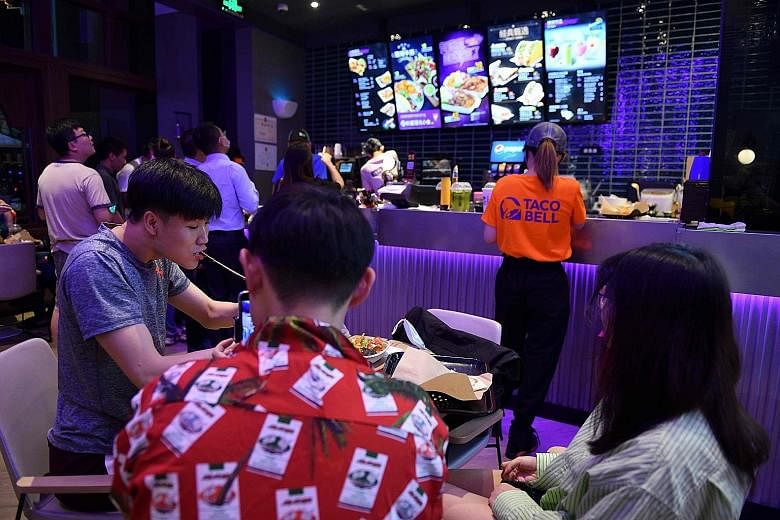BEIJING • In Shanghai, restaurants and bars in many neighbourhoods are teeming with crowds.
In Beijing, thousands of students are heading back to campus for the autumn semester.
In Wuhan, where the coronavirus was first detected eight months ago, water parks and night markets are packed elbow to elbow, buzzing like before.
While the United States and much of the world are still struggling to contain the Covid-19 pandemic, life in many parts of China has in recent weeks become strikingly normal.
Cities have relaxed social distancing rules and mask mandates, and crowds are again filling tourist sites, movie theatres and gyms.
When photos circulated worldwide in recent days showing thousands of people swimming shoulder to shoulder at a pool rave in Wuhan, prompting some criticism overseas, Chinese commentators were quick to defend the party.
Global Times, a state-run newspaper, called the reaction to the photos "foreign sour grapes".
Ms Yuki Liu, a 28-year-old who works at a foreign trading company, and her husband attended the pool party this month in Wuhan.
She said the event made her feel "relaxed and free", like she was enjoying a beach vacation.
"To be honest, I almost forgot about the epidemic. As long as people didn't sneeze all the time or spit, I just felt they were normal people."
The return to normality has made China an outlier in the global economy. The US is facing a potentially long and painful recession, as some places have reimposed restrictions to contend with a surge in coronavirus cases this summer.
Several countries in Europe have been experiencing fresh outbreaks, putting additional pressure on an already weak economy.
By contrast, China has been slowly recovering in recent months, and its factories are humming again, although its growth is still weaker than before the pandemic, and job losses are significant.
It is a stark turnabout from the early days of the pandemic, when the Chinese authorities imposed sweeping lockdowns.
Despite a delayed response and early missteps by the government, the recovery in China points to the success of the extreme tactics.
After months of travel restrictions and citywide testing drives, locally transmitted cases of the virus in China are near zero, according to official data.
China's National Health Commission yesterday reported that China on Sunday had no new locally transmitted cases. The 16 new infections it reported were all imported, bringing China's total number of confirmed cases to 84,967, with the death toll remaining at 4,634.
In the US yesterday, some 5.8 million people have been infected and more than 180,000 have died.
Now, many Chinese cities are once again hosting large events, though with some limits on crowd sizes, after months of such gatherings being banned entirely.
Qingdao, a seaside city in eastern China, is holding its popular beer festival this month largely as planned, and face masks are optional. Shanghai recently held a gaming convention that attracted thousands of enthusiasts.
China's leaders, hoping to bolster the economy, are eager for people to get back to work and start shopping and travelling again.
But they are also taking a cautious approach, requiring movie theatres and tourist sites, for example, to operate at half-capacity.
To get into banks, restaurants and other public venues, residents must undergo temperature checks and show digital codes verifying that they are healthy and have not travelled recently to areas where there have been clusters of new infection cases.
The authorities also continue to restrict travel in the Xinjiang region in western China, where an outbreak last month prompted a lockdown.
China still prohibits most foreigners from entering the country, for fear that they could bring the virus.
There have been outbreaks in recent months, but in each case the response was swift.
When Wuhan - where the outbreak first emerged late last year - reported six Covid-19 cases in May, breaking a streak of more than a month without any confirmed infections, the city launched a plan to test all 11 million of its people.
The state news media is pointing to the return of large gatherings and classes as evidence of China's superior response to the virus, especially when compared with the US and other Western countries whose officials are dealing with a rising number of cases.
China could still face a Covid-19 resurgence, experts warn, especially as the weather cools and people spend more time indoors.
"They still need to be cautious," said Professor David Hui, director of the Stanley Ho Centre for Emerging Infectious Diseases at the Chinese University of Hong Kong. "Mass gatherings and mass celebrations should not be encouraged."
Some Chinese residents are worried that the public is becoming too dismissive of the virus.
Ms Cheng Ailin, 59, who recently visited a gorge in Guangdong that was crowded with tourists, said she was shocked to see that most people were not wearing masks.
"There were no control and prevention measures. If there were a coronavirus case, the consequences would be unimaginable, and the trouble would have no end," she said.
NYTIMES

